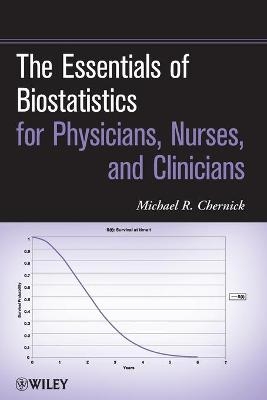
The Essentials of Biostatistics for Physicians, Nurses, and Clinicians
John Wiley & Sons Inc (Verlag)
978-0-470-64185-9 (ISBN)
A fundamental and straightforward guide to using and understanding statistical concepts in medical research
Designed specifically for healthcare practitioners who need to understand basic biostatistics but do not have much time to spare, The Essentials of Biostatistics for Physicians, Nurses and Clinicians presents important statistical methods used in today's biomedical research and provides insight on their appropriate application. Rather than provide detailed mathematics for each of these methods, the book emphasizes what healthcare practitioners need to know to interpret and incorporate the latest biomedical research into their practices.
The author draws from his own experience developing and teaching biostatistics courses for physicians and nurses, offering a presentation that is non-technical and accessible. The book begins with a basic introduction to the relationship between biostatistics and medical research, asking the question "why study statistics?," while also exploring the significance of statisitcal methods in medical literature and clinical trials research. Subsequent chapters explore key topics, including:
Correlation, regression, and logistic regression
Diagnostics
Estimating means and proportions
Normal distribution and the central limit theorem
Sampling from populations
Contingency tables
Meta-analysis
Nonparametric methods
Survival analysis
Throughout the book, statistical methods that are often utilized in biomedical research are outlined, including repeated measures analysis of variance, hazard ratios, contingency tables, log rank tests, bioequivalence, cross-over designs, selection bias, and group sequential methods. Exercise sets at the end of each chapter allow readers to test their comprehension of the presented concepts and techniques.
The Essentials of Biostatistics for Physicians, Nurses, and Clinicians is an excellent reference for doctors, nurses, and other practicing clinicians in the fields of medicine, public health, pharmacy, and the life sciences who need to understand and apply statistical methods in their everyday work. It also serves as a suitable supplement for courses on biostatistics at the upper-undergraduate and graduate levels.
Michael R. Chernick, PhD, is Manager of Biostatistical Services at Lankenau Institute for Medical Research, where he conducts statistical design and analysis for pharmaceutical research. He has more than thirty years of experience in the application of statistical methods to such areas as medicine, energy, engineering, insurance, and pharmaceuticals. Dr. Chernick is the author of Bootstrap Methods: A Guide for Practitioners and Researchers, Second Edition, and the coauthor of Introductory Biostatistics for the Health Sciences: Modern Applications Including Bootstrap, both published by Wiley.
Preface ix 1. The What, Why, and How of Biostatistics in Medical Research 1
1.1 Defi nition of Statistics and Biostatistics, 1
1.2 Why Study Statistics?, 3
1.3 The Medical Literature, 9
1.4 Medical Research Studies, 11
1.4.1 Cross-sectional studies including surveys, 11
1.4.2 Retrospective studies, 12
1.4.3 Prospective studies other than clinical trials, 12
1.4.4 Controlled clinical trials, 12
1.4.5 Conclusions, 13
1.5 Exercises, 14
2. Sampling from Populations 15
2.1 Definitions of Populations and Samples, 17
2.2 Simple Random Sampling, 18
2.3 Selecting Simple Random Samples, 19
2.4 Other Sampling Methods, 27
2.5 Generating Bootstrap Samples, 28
2.6 Exercises, 32
3. Graphics and Summary Statistics 34
3.1 Continuous and Discrete Data, 34
3.2 Categorical Data, 35
3.3 Frequency Histograms, 35
3.4 Stem-and-Leaf Diagrams, 38
3.5 Box Plots, 39
3.6 Bar and Pie Charts, 39
3.7 Measures of the Center of a Distribution, 42
3.8 Measures of Dispersion, 46
3.9 Exercises, 50
4. Normal Distribution and Related Properties 51
4.1 Averages and the Central Limit Theorem, 51
4.2 Standard Error of the Mean, 53
4.3 Student's t-Distribution, 53
4.4 Exercises, 55
5. Estimating Means and Proportions 58
5.1 The Binomial and Poisson Distributions, 58
5.2 Point Estimates, 59
5.3 Confi dence Intervals, 62
5.4 Sample Size Determination, 65
5.5 Bootstrap Principle and Bootstrap Confidence Intervals, 66
5.6 Exercises, 69
6. Hypothesis Testing 72
6.1 Type I and Type II Errors, 73
6.2 One-Tailed and Two-Tailed Tests, 74
6.3 P-Values, 74
6.4 Comparing Means from Two Independent Samples: Two-Sample t-Test, 75
6.5 Paired t-Test, 76
6.6 Testing a Single Binomial Proportion, 78
6.7 Relationship Between Confi dence Intervals and Hypothesis Tests, 79
6.8 Sample Size Determination, 80
6.9 Bootstrap Tests, 81
6.10 Medical Diagnosis: Sensitivity and Specificity, 82
6.11 Special Tests in Clinical Research, 83
6.11.1 Superiority tests, 84
6.11.2 Equivalence and bioequivalence, 84
6.11.3 Noninferiority tests, 86
6.12 Repeated Measures Analysis of Variance and Longitudinal Data Analysis, 86
6.13 Meta-Analysis, 88
6.14 Exercises, 92
7. Correlation, Regression, and Logistic Regression 95
7.1 Relationship Between Two Variables and the Scatter Plot, 96
7.2 Pearson's Correlation, 99
7.3 Simple Linear Regression and Least Squares Estimation, 101
7.4 Sensitivity to Outliers and Robust Regression, 104
7.5 Multiple Regression, 111
7.6 Logistic Regression, 117
7.7 Exercises, 122
8. Contingency Tables 127
8.1 2 x 2 Tables and Chi-Square, 127
8.2 Simpson's Paradox in the 2 x 2 Table, 129
8.3 The General R x C Table, 132
8.4 Fisher's Exact Test, 133
8.5 Correlated Proportions and McNemar's Test, 136
8.6 Relative Risk and Odds Ratio, 138
8.7 Exercises, 141
9. Nonparametric Methods 145
9.1 Ranking Data, 146
9.2 Wilcoxon Rank-Sum Test, 146
9.3 Sign Test, 149
9.4 Spearman's Rank-Order Correlation Coefficient, 150
9.5 Insensitivity of Rank Tests to Outliers, 153
9.6 Exercises, 154
10. Survival Analysis 158
10.1 Time-to-Event Data and Right Censoring, 159
10.2 Life Tables, 160
10.3 Kaplan–Meier Curves, 164
10.3.1 The Kaplan-Meier curve: a nonparametric estimate of survival, 164
10.3.2 Confidence intervals for the Kaplan-Meier estimate, 165
10.3.3 The logrank and chi-square tests: comparing two or more survival curves, 166
10.4 Parametric Survival Curves, 168
10.4.1 Negative exponential survival distributions, 168
10.4.2 Weibull family of survival distributions, 169
10.5 Cox Proportional Hazard Models, 170
10.6 Cure Rate Models, 171
10.7 Exercises, 173
Solutions to Selected Exercises 175
Appendix: Statistical Tables 192
References 204
Author Index 209
Subject Index 211
| Zusatzinfo | Charts: 4 B&W, 0 Color; Drawings: 1 B&W, 0 Color; Tables: 0 B&W, 0 Color; Graphs: 11 B&W, 0 Color |
|---|---|
| Verlagsort | New York |
| Sprache | englisch |
| Maße | 156 x 235 mm |
| Gewicht | 349 g |
| Themenwelt | Mathematik / Informatik ► Mathematik ► Wahrscheinlichkeit / Kombinatorik |
| Medizin / Pharmazie ► Medizinische Fachgebiete | |
| Studium ► Querschnittsbereiche ► Epidemiologie / Med. Biometrie | |
| ISBN-10 | 0-470-64185-1 / 0470641851 |
| ISBN-13 | 978-0-470-64185-9 / 9780470641859 |
| Zustand | Neuware |
| Haben Sie eine Frage zum Produkt? |
aus dem Bereich


